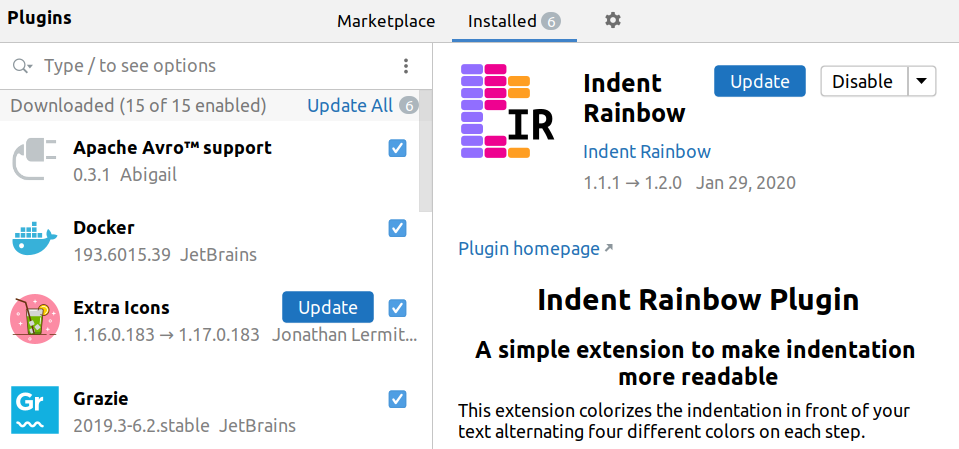
- #INTELLIJ JAVA VERSION FOR FREE#
- #INTELLIJ JAVA VERSION HOW TO#
- #INTELLIJ JAVA VERSION CODE#
- #INTELLIJ JAVA VERSION DOWNLOAD#
You can also call the implicit methods that are generated automatically for a record. The default constructor of a record accepts values for its components in the order of their definition. You can instantiate a record by using the operator new. The methods toString(), hashCode(), and equals() are also generated automatically for records. Since a record is supposed to be immutable, no setter methods are defined. Interestingly, the name of the getter method is the same as that of the data variable (it doesn’t start with ‘ get‘ or ‘ is‘). For each of the components of the record Person, the compiler defines a final instance variable ( name and age).

#INTELLIJ JAVA VERSION CODE#
We can open the Person.class file in IntelliJ IDEA to view its decompiled version (in the project window, scroll to folder ‘out’ and click on Person.class to open it in the editor window):Īs you can see in the decompiled code for the record Person, the compiler (re)defines it as a final class, extending the class from the core Java API. The compilation process creates a full-blown class, adding instance variables and methods to a record.
#INTELLIJ JAVA VERSION DOWNLOAD#
In this case, please download the JDK from the provider’s website and then configure IntelliJ IDEA to use it. This is due to the various rules that apply to them – you need to explicitly accept certain conditions before using them. All JDK versions from various providers might not be visible in this dialog box. Starting with IntelliJ IDEA 2020.1, you can also download the JDK from within IntelliJ IDEA and configure it.
#INTELLIJ JAVA VERSION FOR FREE#
The exciting news is that you can participate in IntelliJ IDEA’s EAP (Early Access Program) to download its preview builds for free and try out the Java 14 features today.Ĭonfigure IntelliJ IDEA 2020.1 to use JDK 14 for Project SDK and choose the Project language level as ‘14 (Preview) – Records, patterns, text blocks’ for your Project and Modules settings. Java 14 features are supported in IntelliJ IDEA 2020.1, which will be released in April 2020. To create a record using IntelliJ IDEA 2020.1, select ‘Record (Preview Feature)’ in the ‘New Java Class’ dialog box. With just one line of code, the preceding example defines a record Person with two components name and age.

Though it helps cut down significantly on the boilerplate code, this isn’t the primary reason for its introduction. Records introduce a new type declaration in Java which simplifies the task of modeling your data as (shallowly immutable) data.
#INTELLIJ JAVA VERSION HOW TO#
In this article, I will cover what records are, talk about pattern matching for instanceof, new features in Text Blocks, and explain how to use them all in IntelliJ IDEA. Switch Expressions have been added as a standard language feature in Java 14, with no changes from its previous version (it was introduced in Java 12 as a preview language feature). Released as a preview language feature in Java 13, Text Blocks add new escape sequences to improve the processing of whitespaces in multi-line string values. After introducing a binding variable, you don’t need additional variables or explicit casting, which also makes your code safe and concise to write and read. The usage of the instanceof operator is simplified with Pattern Matching for instanceof. Don’t worry – the compiler does the heavy lifting to add the methods required to make the class work for you. By using just a single line of code, you can model your data with ease. With Records, you get a compact syntax for declaring data classes.

It also adds Switch Expressions as a Standard language Feature. It includes Records and Pattern Matching for instanceof as preview language features, and Text Blocks in the second preview. Expand the Jetty plugin and double click jetty:run.Java 14 packs a lot of Java language features for you. Under Maven Projects, expand your web app project, click plugins. The final pom.xml should be something similar to this Įxpand the Maven tab. Jetty plugin will be our web app container like tomcat, jboss, glassfish, etc. Next, under the build section, we will add the jetty plugin. Locate the and and change the version to 1.8 since we wanted to use Java 8. Let’s edit this XML and add our own configurations. By default, since we created the application using an archetype, IntelliJ automatically adds the default configuration to run a web application.


 0 kommentar(er)
0 kommentar(er)
